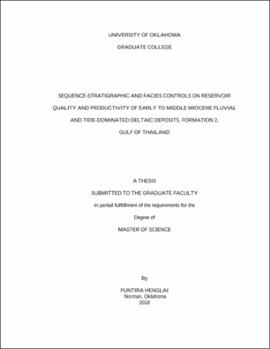| dc.description.abstract | The Early to Middle Miocene Formation 2 is the main contributor to hydrocarbon production in the Gulf of Thailand. Formation 2 consists of nine key lithofacies deposits in fluvial and tide-dominated deltaic environments. These lithofacies include 1) coal, 2) organic claystone, 3) bioturbated and laminated claystone, 4) heterolithic sandstone, 5) parallel-laminated sandstone, 6) ripple cross-laminated sandstone 7) cross-bedded sandstone, 8) structureless sandstone, and 9) conglomerate. Two methods of electrofacies classification were used to estimate rock types in non-cored wells, including Artificial-Neural Networks (ANNs) and K-means clustering. For mapping purposes, lithofacies are combined into four lithologies: 1) coal, 2) claystone, 3) heterolithic sandstone, and 4) sandstone. Using ANNs classification with an overall accuracy of 85%, lithology logs were estimated to establish a sequence-stratigraphic framework and to map reservoir properties.
Formation 2 strata form a subset of a large first-order transgressive sequence that includes the underlying Formation 0, Formation 1, and the overlying Formation 3. Formation 2 stratigraphic framework consists of five third-order stratigraphic cycles named, from deepest to shallowest, units 2A-E. The moderate eustatic sea-level rise approximately 19 Ma resulted in a variety of depositional environments, facies distributions, and their reservoir properties. Units 2A-C represent a continuous transgression and landward shift of facies. The top of unit 2C possibly indicates the maximum landward extent of the shoreline. Unit 2D records a major regression and basinward shift of facies resulting from the combination of a glacio-eustatic sea-level fall and tectonic uplift in this region.
Three-dimensional reservoir models illustrate the spatial distribution of lithology, porosity, permeability, and pore volume of the fluvial and tide-dominated deltaic deposits. Sandstone percentage and reservoir quality directly relates to the regressive cycle, unit 2D, while transgressive cycles 2A-C exhibit lower sandstone content and reservoir quality. A combination of the stratigraphic variability of fluvial and deltaic sandstones and fault compartmentalization control hydrocarbon accumulation. | en_US |
